Transcription of Specifying Data - AMPL
1 9_____Specifying DataAs we emphasize throughout this book, there is a distinction between anAMPL modelfor an optimization problem, and the data values that define a particular instance of theproblem. Chapters 5 through 8 focused on the declarations of sets, parameters, variables,objectives and constraints that are necessary to describe models. In this chapter and thenext, we take a closer look at the statements that specify the ofAMPL data statementsappear in almost every chapter. These statementsoffer several formats for lists and tables of set and parameter values. Some formats aremost naturally created and maintained in a text editing or word processing environment,while others are easy to generate from programs like database systems and (Chapter 12) also produces output in these formats.
2 Whereverpossible, similar syntax and concepts are used for both sets and chapter first explains howAMPL sdatacommand is used, in conjunction withdata statements, to read data values from files such as those whose names end our examples. Options to thedatacommand also allow or force selectedsets and parameters to be read sections describe data statements, first for lists and then for tables of setand parameter data , followed by brief sections on initial values for variables, values forindexed collections of sets, and default values. A summary of data statement formatsappears in Section final section describes thereadcommand, which readsunformattedlists of valuesinto sets and parameters.
3 Chapter 10 is devoted toAMPL s features for data stored inrelational database Formatted data : thedatacommandDeclarations likeparamandvar, and commands likesolveanddisplay, areexecuted inmodel mode, the standard mode for most modeling activity. But model modeis inconvenient for reading long lists of set and parameter values. InsteadAMPL reads its143144 Specifying data CHAPTER 9data statements in adata modethat is initiated by thedatacommand. In its most com-mon use, this command consists of the keyworddatafollowed by the name of a example,ampl: data ;reads data from a file Filenames containing spaces, semicolons, ornonprinting characters must be enclosed in reading in data mode,AMPL treats white space, that is, any sequence of space,tab, and newline characters, as a single space.
4 Commas separating strings or numbersare also ignored. Judicious use of these separators can help to arrange data into easy-to-read lists and tables; our examples use a combination of spaces and newlines. If datastatements are produced as output from other data management software and sent directlytoAMPL, however, then you may ignore visual appearance and use whatever format files often contain numerous character strings, representing set members or thevalues of symbolic parameters. Thus in data modeAMPL does not, in general, requirestrings to be enclosed in quotes. Strings that include any character other than letters, dig-its, underscores, period,+and-must be quoted, however, as in the case ofA&P.
5 Youmay use a pair of either single quotes ( A&P ) or double quotes ("A&P"), unless thestring contains a quote, in which case the other kind of quote must surround it("DOMINICK S") or the surrounding quote must be doubled within it( DOMINICK S ).A string that looks like a number (for example"+1"or"3e4") must also be quoted,to distinguish it from a set member or parameter value that is actually a number. Num-bers that have the same internal representation are considered to be the same, so that forexample2, , +2all denote the same set reading a file in data mode, it normally reverts to whatevermode it was in before thedatacommand was executed.
6 Hence a data file can itself con-taindatacommands that read data from other files. If the last data statement in a datafile lacks its terminating semicolon, however, then data mode persists regardless of theprevious with no filename putsAMPL into data mode, so subsequent inputis taken as data statements:ampl:model ;ampl: data ;ampl data :set MINREQ := A B1 B2 C CAL;ampl data :set MAXREQ := A NA CAL;ampl data :display NUTR;set NUTR := A B1 B2 C CAL NA;ampl:AMPL leaves data mode when it sees any statement (likedisplay) that does not beginwith a keyword (likesetorparam) that begins adatastatement. Themodelcom-mand, with or without filename, also causes a return to model data IN LISTS145 Model components may be assigned values from any number of data files, by usingmultipledatacommands.
7 Regardless of the number of files,AMPL checks that no com-ponent is assigned a value more than once, and duplicate assignments are flagged aserrors. In some situations, however, it is convenient to be able to change the data by issu-ing newdatastatements; for example, after solving for one scenario of a model, youmay want to modify some of the data by reading a new data file that corresponds to a sec-ond scenario. The data values in the new file would normally be treated as erroneousduplicates, but you can tellAMPLto accept them by first giving areset dataorupdate datacommand. These alternatives are described in Section , along withthe use ofreset datato resample randomly-computed parameters, and oflettodirectly assign new set or parameter data in listsFor an unindexed (scalar) parameter, a data statement assigns one value:param avail := 40;Most of a typical model s parameters are indexed over sets, however, and their values arespecified in a variety of lists and tables that are introduced in this section and the next, start with sets of simple one-dimensional objects, and the one-dimensional collec-tions of parameters indexed over them.
8 We then turn to two-dimensional sets and param-eters, for which we have the additional option of organizing the data into slices . Theoptions for two dimensions are then shown to generalize readily to higher dimensions, forwhich we present some three-dimensional examples. Finally, we show how data state-ments for a set and the parameters indexed over it can be combined to provide a moreconcise and convenient of one-dimensional sets and parametersFor a parameter indexed over a one-dimensional set likeset PROD;param rate {PROD} > 0;the specification of the set can be simply a listing of its members:set PROD := bands coils plate ;and the parameter s specification may be virtually the same except for the addition of avalue after each set member:param rate := bands 200 coils 140 plate 160.
9 The parameter specification could equally well be written146 Specifying data CHAPTER 9param rate :=bands 200coils 140plate 160 ;since extra spaces and line breaks are a one-dimensional set has been declared with the attributeorderedorcircular(Section ), then the ordering of its members is taken from the data state-ment that defines it. For example, we specifiedset WEEKS := 27sep 04oct 11oct 18oct ;as the membership of the ordered setWEEKSin Figure of a set must all be different;AMPL will warn of duplicates:duplicate member coils for set PROD context: set PROD := bands coils plate coils >>> ; <<<Also a parameter may not be given more than one value for each member of the set overwhich it is indexed.
10 A violation of this rule provokes a similar message:rate[ bands ] already definedcontext: param rate := bands 200 bands 160 >>> ; <<<The context bracketed by>>>and<<<isn t the exact point of the error, but the messagemakes the situation set may be specified as empty by giving an empty list of members; simply put thesemicolon right after the:=operator. A parameter indexed over an empty set has no dataassociated with of two-dimensional sets and parametersThe extension of data lists to the two-dimensional case is largely straightforward, butwith each set member denoted by a pair of objects. As an example, consider the follow-ing sets from Figure 6-2a:set ORIG; # originsset DEST; # destinationsset LINKS within {ORIG,DEST}; # transportation linksThe members ofORIGandDESTcan be given as for any one-dimensional sets:set ORIG := GARY CLEV PITT ;set DEST := FRA DET LAN WIN STL FRE LAF ;Then the membership ofLINKSmay be specified as a list of tuples such as you wouldfind in a model s indexing expressions,set LINKS :=(GARY,DET) (GARY,LAN) (GARY,STL) (GARY,LAF) (CLEV,FRA)(CLEV,DET) (CLEV,LAN) (CLEV,WIN) (CLEV,STL) (CLEV,LAF)(PITT,FRA) (PITT,WIN) (PITT,STL) (PITT,FRE).











